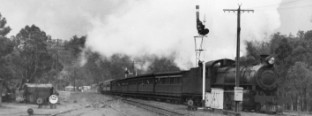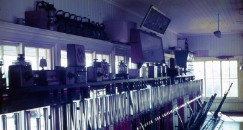Fremantle Box B
WAGR - Eastern Railway (E. R.) | |
1938 WAGR MAP Mileage = 12 | |
Next Down Station: | Next Up Station: |
FREMANTLE BOX 'A' (N.G.) | |
Quick Facts | |
Opened | Closed |
01/07/1907 | 1991 |
Mechanical | Electrical |
80 Levers | Illuminated Diagram |
Fate: Demolished | |
Photographs and track diagrams of the Fremantle station area around that period fail to show any sign of this cabin. If anything, they only serve to reveal the existence of two much earlier timber cabins, one of which is also not reflected in the official signal cabin record system - for many years kept up very studiously by the W. A. G. R. Signals Branch. The first of these cabins, was simply named "Fremantle" and was situated on the end of the ocean side platform of the original Fremantle (Cliff Street) terminus station, whilst the other cabin, known officially as "South Quay Cabin" or sometimes "Fremantle Goods Yard Box" was near the very long footbridge which once spanned the entire railway complex, joining the bustling town to the ever busy docks. This latter box was demolished in late November 1905, possibly due to changes in the yard layout in preparation for the building of the imposing new Fremantle station in 1907.
Fremantle Box 'B' was located on the Perth side of the 1907 Fremantle station, and for the last few decades of its life had a wonderful view (not) of the massive woolstores buildings just across the road), although the window frames on the opposite side of the cabin (facing the harbour) were adorned with lists of the names of many of the ships which visited the harbour.
It was of an interesting brick design, perhaps reminiscent of Perth Box 'C'. From the outside, it had the classic W.A.G.R. over-large roof to help shade the cabin in the hot summer months.
The very long external staircase, was a bit of a worry in the winter time though, as Fremantle was subject to very cold, driving winds and rain, and the trek across the multitude of tracks to the cabin, and then the long ascent in winter was not for the faint hearted!
The exterior photo was taken in the early 1970s, when some of the other yard buildings were still in place. One of the sheds on the left of the cabin was used by the shunters, and there was plenty of stories told of the rivalries between the shunters and Signalmen over the years. One such episode, was of the continuing practical jokes played out between the two groups of workers. It has been said that a Signalman, keen to 'get back' at the shunters for some prior trick, visited and exited the Shunter's 'humpy' without being seen. Some days later, the shunters began to notice an odd smell in in the tiny room. This room served as their refuge from the weather and their lunch room, so it when they couldn't find the cause of the offensive odour, they were rightly concerned. All was revealled however, when the fish that the Signalman had quite cleverly concealed underneath the table rotted through it's supporting newspaper. It is not recorded what was said after this, but one could bet that it was every bit as foul as the smell!
Towards the end of its life, Fremantle Box 'B' endured the policy of painting lever handles silver as in the Claremont Cabin. Being the 'end of the line' for suburban services to Fremantle, and therefore for many years the end of the Sykes Lock and Block working along that line, the cabin was, almost until the last months of its life, attended by Signalmen twenty four hours a day, all year round - so there was no shortage of lever-cleaning staff! Interesting to note in the picture, is that the Facing Point Lock levers - normally a dark blue colour, are almost sky-blue here. Also, the spare levers near the camera stand testimony of the fact that Fremantle Box 'A' had been rendered obsolete and that end of the yard re-signalled.
Fremantle Box 'B' could work on the eastern side, with East Fremantle Goods Junction Box (demolished in 1964); North Fremantle; Cottesloe; and on the odd occasion with Claremont, Subiaco or more likely on weekends directly with Perth Box 'B'. To the west, Fremantle Box 'B' worked with Fremantle Box 'A', a small, low level cabin located at the other end of the station for narrow gauge trains, or with Robb Jetty for standard gauge trains.
Fremantle Box 'B' accommodated an 80 lever McKenzie & Holland No. 9 pattern frame. There were a number of controlled (slotted) signals jointly worked with Fremantle Box 'A'. Unlike some of the electrically controlled signals between Perth Box 'B' and Perth Box 'C', these were worked mechanically. Of these, Nos. 78, 79 & 80 Home Signals at the Cliff Street level crossing, were quite some distance from Fremantle Box 'B'. Due to the length of the signal wire run from Box 'B', and the weight of the signal arm's couterweight, the Signalman at Fremantle 'A' was encouraged not to operate his controlled signal lever until he could see the counterweight on the post (pulled by Box 'B') rise. Needless to say, this was not always done, and was only achieved if the 'A' Cabin Signalman was extra diligent, or feeling particularly generous!
Proving that it was not only signals that could be controlled, the YELLOW lever - No. 55 - seen in the photo above, controlled No. 12 Points lever in Box 'A', and when normal in the frame, it prevented the Box 'A' Signalman from setting a movement across the narrow / standard gauge diamond crossing. On pulling No. 55 in Box 'B', the Signalman here was prevented from setting any conflicting standard gauge moves toward the diamond crossing.
The Fremantle Box 'B' Signalman controlled the up and down main lines, (the start of the Eastern Railway), and for many years access to the three platform roads, Fremantle Locomotive depot and busy goods yards either side of the main lines. In 1966, the Standard Gauge line was laid through Fremantle for trains servicing the new standard gauge marshalling yard at Leighton and the north wharf container terminal. This, and the general downturn in non-container rail goods traffic to and from the south wharf meant that a lot of the narrow gauge yard was discontinued. For the last 30 years of the cabin's life, Fremantle Box 'B' controlled the passage of Westrail's largest (3,300Hp) locomotives, the mighty L Class - a far cry from the diminutive narrow gauge 2-6-0 (A Class) steam locomotive which began the construction of the line in July 1880. Two legendary British locomotives - the Flying Scotsman and the Pendennis Castle have even passed by the box under the watchful eye of Western Australian Signalmen!
Information researched and interpreted by Chris. J. E. French of SignallingWA
Buy this page or View your SignallingWA Shopping Cart
Photographs © by Chris. J. E. French
This page is copyright, and permission must be sought from SignallingWA before this page is used for any purpose other than personal education.
FREMANTLE BOX 'B' Employees | ||
This list may not be complete and does not yet include employees who worked here without being appointed. Where an appointment date is unknown, the Weekly Notice (WN) date advising of the appointment or other official documentation, i.e. Certificate of Competency (CC) will be used. | ||
Name | Appointed | Position |
| Gardiner, William | 15/05/1966 | Signalman, Class 2 |
| Warne, Rex Lindsay | 07/03/1975 - CC | Signalman, Class 2 |
| Rance, Fred | 15/07/1975 - CC | Signalman, Class 2 |
Warne, Rex Lindsay | 16/12/1975 - CC | Signalman, Class 1 |
| French, Chris. J. E. | 19/06/1979 - CC | Signalman, Class 1 |
| Howman, William G. | 14/11/1979 | Signalman, Class 1 |
| Cardinal, Basil E. | 15/11/1979 | Signalman, Class 1 |
| Gardiner, William | 10/03/1980 | Signalman, Class 1 |
| Bentley-Taylor, Gary | 14/09/1982 | Signalman |
| Bailey, Phillip W. | 21/06/1985 - CC | Signalman, Class 2 |
Is a name missing? Please submit any corrections / additions with suitable evidence using the e-mail form above. | ||
01/03/2013 - Former W. A. G. R. Employee Fred Rance remembers:
"During 1975 I transfered to Fremantle from Forrestfield as Signalman Box B Fremantle. After 3 weeks of learning the cabin I was passed out as a Signalman.
It was interesting working there when you had a standard gauge train coming from Robb Jetty going to Leighton and you had to time it through the yard and not block the surburban passenger trains and plan it so that the SG train did not get stuck on the grade going up to the bridge, as it was a heavy pull for the trains going in that direction. After a while I was sent down to Fremantle A cabin to learn that one as well, it was required because on night shift there was only one Signalman on duty and if a train or light engine (a locomotive by itself) came from Robb Jetty you would set the road in Box B then walk down to box A. Once it had gone and you had entered the details in the train register book you would cut the cabin out and return to Box B and reset the points and signals back to normal positions. I did this one night and because it was raining I was running down the yard and it wasn't lit very well and I tripped over the signal wires, took a bit of 'bark' off, picked myself up and carried on.
One dayshift about 1500hrs I had trouble getting one of the main signals to clear, I went downstairs to check the interlocking and when I got over to the points I found the FACING POINT LOCKBAR had actually broken, so I went back to the cabin, rang Control and told him I would chock the facing the points and hand signal the trains into Fremantle. I did that for a couple of trains before my relief arrived. He took over and worked the cabin while I stayed on duty to work under his directions until the Interlocking Fitter arrived to fix the fault. Delays were minimal. In 1976 the cabin was upgraded to 1st class and as I only had a 2nd class ticket I transfered back to Forrestfield to work on the Hump Control again."


